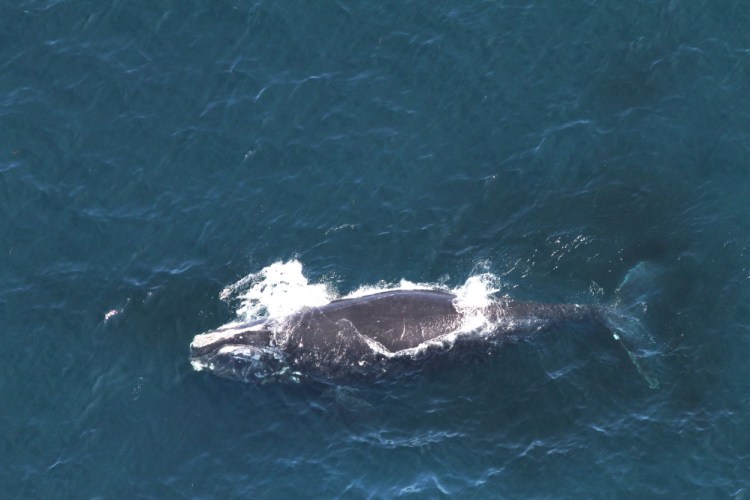The right whale that died in the waters off Maine in recent days had no name, but rather a number – 3694 – given to her by researchers at the New England Aquarium, who track this endangered species in the North Atlantic.
She was young, just coming into her reproductive years and had tangled with fishing gear once before, sometime in the past four years.
Since she was first spotted in 2006, 3694 had been seen and identified 26 times – eight times from vessels, the rest from the air, either from planes or drones. Before the crew on a whale-watching trip out of Boothbay spotted her, floating on the surface and wrapped in fishing gear ropes Friday, the last time anyone had made a positive identification of 3694 was in Florida waters. That was Feb. 12. At that time she was swimming freely, unencumbered by any fishing line.
The New England Aquarium’s best guess on her age is that she was calved in 2005, making her 11½ at the time of her death. She was probably just entering her reproductive years – right whales begin to reproduce at age 10, and give birth every three to five years after that.
Because she was spotted in Florida, the largest calving ground for right whales, it’s possible she did give birth this year and lost the calf, but that’s just speculation. “We won’t be able to prove that she was pregnant,” said Amy Knowlton, research associate with the New England Aquarium.
She’d been sighted in Cape Cod Bay, the Great South Channel, the Gulf of Maine and farther out, in the mid-Atlantic. But very little was known about this whale.
“She was hard for us to match because she didn’t have distinctive scars or markings,” Knowlton said. “She was a tough one.”
She had a small white scar on her chin, and another near her left blowhole. They were minor. Sometime after 2012 she had a tussle with fishing line, which left a leading edge fluke scar. But it was minor.
Because of this lack of obvious identifiers, 3694 never got a name, which researchers give only when there is a feature on a whale that helps them identify the creature. (The number itself does not signify an overall count of North Atlantic right whales. There are now about 476 of them, scientists said.)
She’d never been darted to collect a tissue sample for genetic testing, a tool that whale researchers have been using since the late 1980s to determine the exact parentage of calves as well as their gender. Indeed, until the necropsy conducted at Benson Farm in Gorham over the weekend, not even 3694’s sex was known.
She weighed about 45 tons and was 43 feet long, big enough that a tractor-trailer was required to bring her from Portland – where a Coast Guard boat had towed her – to Gorham.
When the Cap’n Fish’s Whale Watching cruise out of Boothbay spotted 3694 at around 1:30 p.m. Friday, she was already dead. At first, they took her for a log. “They decided to go look closer,” said John Fish, owner of the popular whale-watching line. “It was a whale all wrapped up in fishing gear that it had been choked out. It is a sad way to die.”
There’s no doubt, Knowlton said, that she died from what is called “chronic entanglement” among whale researchers.
“It’s not a pretty ending,” Knowlton acknowledged. Number 3694 could have been wrapped in the line for months. It was in her mouth, so it’s possible she picked it up while feeding. Right whales are especially susceptible to such entanglements because they feed on plankton near the surface, swimming slowly with their mouths wide open.
“Clearly it got very wrapped up,” Knowlton said. “Ropes are very strong now and when (whales) can’t break through, they are going to continue to struggle. And that is what happened with her.”
Most of the right whales surveyed in the Bay of Fundy this summer had begun to leave by mid-September, so it’s likely that 3694 was on the move. The Boothbay region is not known as a high-use area for right whales, Knowlton said.
Although Fish said it has been a great year for whale-watching in general, with tourists enjoying up-close looks at humpbacks, minke, fin whales and even Sei whales, right whales have been conspicuously absent. “That was the only right whale we’ve seen in a long, long time,” Fish said.
He said the captain of the boat and the marine biologist who narrates during the cruise had told him that the whale had not started to give off odors and there were no obvious signs of shark damage to the corpse, suggesting the whale hadn’t been dead long. Last year when the crew spotted a humpback tangled in gear and called it in – the National Oceanic and Atmospheric Administration has an emergency line for just such cases – a team was able to free the humpback.
There were no other whales around 3694 when she was spotted.
As an individual, 3694 may have lacked much of a profile; there was not even enough that was distinctive about her to go by a nickname – Chin Scar, for instance. But as part of the small collective of right whales and those who track them, her death will be felt as potential lost at sea, the potential to perpetuate the species by becoming a mother.
“She was just getting to that age,” Knowlton said. “That is why this is even more of a sad loss.”
Send questions/comments to the editors.




Comments are no longer available on this story